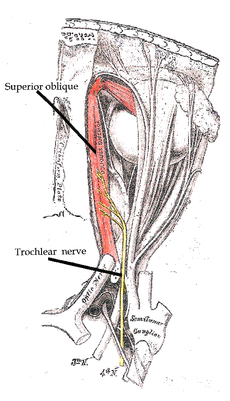- Congenital fourth nerve palsy
-
Congenital fourth nerve palsy Classification and external resources 
Trochlear nerveICD-10 H49.1 ICD-9 378.53 eMedicine oph/697 MeSH D020432 Congenital fourth nerve palsy is a condition present at birth characterized by a vertical misalignment of the eyes due to a weakness or paralysis of the superior oblique muscle.
Other names for fourth nerve palsy include superior oblique palsy and trochlear nerve palsy.
Contents
Pathophysiology
The fourth cranial nerve innervates the superior oblique muscle for each eye. The superior oblique muscle is one of the six extraocular muscles that allow movement of eye. Specifically, the superior oblique muscle primarily intorts the eye (such that the top of the eye rolls toward the nose), with secondary actions of depression (downgaze) and abduction (looking away from the nose). When this muscle’s function is diminished due to a fourth cranial nerve (CN IV) palsy, the affected eye will extort, deviate upward (hypertropia), and, to a smaller extent, drift inward.
Causes
The cause of congenital fourth nerve palsy is unclear in most cases. Though usually neurogenic in origin, due to a dysgenesis of the CN IV nucleus or nerve, a clinically similar palsy may result from absence or mechanical dysfunction (e.g., abnormal laxity) of the superior oblique tendon. Usually unilateral, congenital fourth nerve palsies can also occur bilaterally. Bilateral congenital fourth nerve palsy may be unmasked only after corrective surgery of one eye for what was thought to be a unilateral palsy.
Presentation
Though present from birth, congenital fourth cranial nerve palsy may not become symptomatic until later childhood or adulthood. Young children adopt a compensatory head position in order to compensate for the underacting superior oblique muscle. The characteristic head tilt is usually away from the affected side to reduce the second image. Old photographs may reveal the presence of a consistent head tilt (torticollis) from an early age. Most patients with congenital CN IV palsy have facial asymmetry due to the chronic head tilt. Other compensatory measures for congenital fourth nerve palsy are development of large vertical fusional amplitudes and lack of subjective symptoms of torsion, even in the presence of great ocular rotation.
Congenital fourth nerve palsy may remain undetected until adulthood, when intermittent diplopia may arise, due to decompensated ability to overcome the vertical deviation. Reduced vertical fusional reserves result from fatigue (stress, fever, other illnesses) or simply the effects of old age. Diplopia from congenital fourth nerve palsy has occasionally been reported to manifest transiently during pregnancy. Congenital fourth nerve palsy may also become evident following cataract surgery once binocular vision is restored after a long period of progressive monocular visual loss and accompanying vergence decompensation. Other adult patients complain of neck pain, after years of head tilting.
Treatment
Symptomatic congenital fourth cranial nerve palsy can be treated with strabismus surgery, where muscle attachment sites on the globe are modified to realign the eyes. Prism lenses set to make minor optical changes in the vertical alignment may be prescribed instead of or after surgery to fine-tune the correction.
References
- Glaser, Joel ed. Neuro-ophthalmology, 3rd edition. Lippincott Williams & Wilkins, 1999. p 413-415.
- Duker, Jay and Myron Yanoff, editors. Ophthalmology, 2nd edition. Mosby, 2004. p 1318
- Sheik, Zafar A and Kelly A Hutcheson, “Trochlear Nerve Palsy,” eMedicine.com; August 4, 2005, accessed Jan 10 2006
See also
Categories:- Disorders of ocular muscles, binocular movement, accommodation and refraction
Wikimedia Foundation. 2010.
